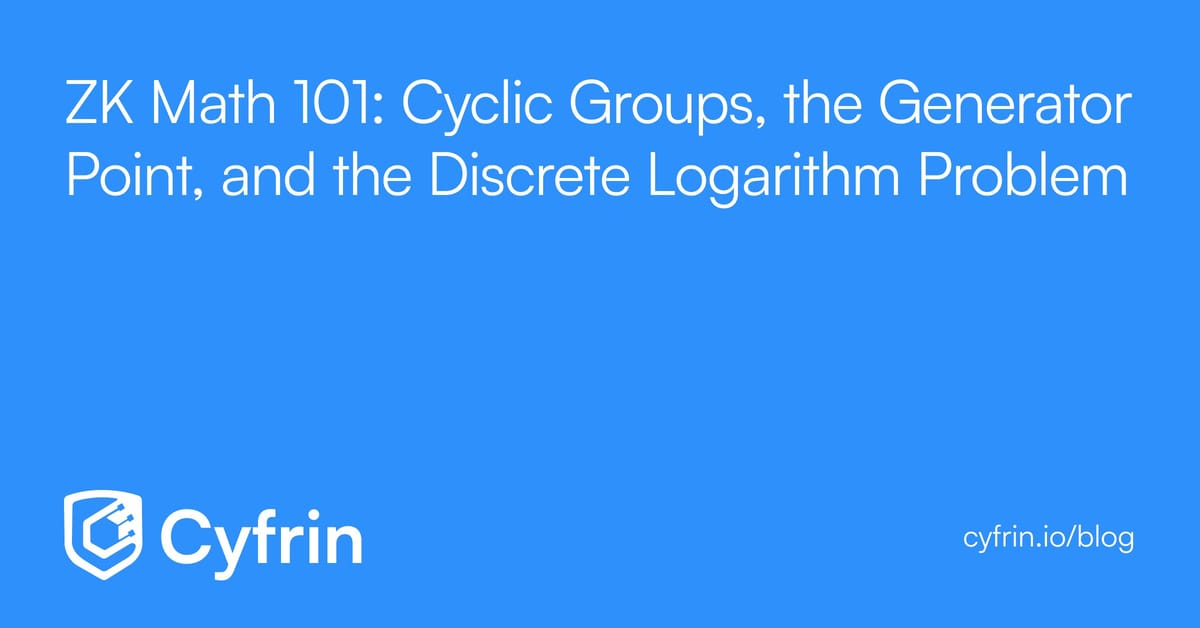Cyclic Groups & Discrete Log Problem Explained: The Math Behind Cryptography Security

Source: ZK Math 101: Cyclic Groups, the Generator Point, and the Discrete Logarithm Problem | Cyfrin
This article breaks down the role of cyclic groups in cryptography and zero-knowledge proofs (ZKPs), highlighting why the difficulty of the discrete logarithm problem (DLP) makes these groups a cornerstone in secure protocols.
What Are Cyclic Groups?
A cyclic group is a mathematical structure where every element can be generated by repeatedly applying the group operation to a single element, called the generator (denoted as g).
Key Group Properties Recap
A group G with operation ∗ is defined by:
How Cyclic Groups Work
- Closure: For any a, b ∈ G, a ∗ b results in c ∈ G.
- Identity: There is an identity element I where a ∗ I = a.
- Inverse: Every element a ∈ G has an inverse a⁻¹ so that a ∗ a⁻¹ = I.
- Associativity: (a ∗ b) ∗ c = a ∗ (b ∗ c).
- For a multiplicative group, the generator g raised to integer powers covers all elements:
g, g², g³, … , gⁿ = every element in G.
- For additive groups, repeated addition of g generates all elements.
Examples:
- Integers modulo n under addition form a cyclic group generated by 1.
- The multiplicative group of integers modulo a prime number p (denoted Zp) is cyclic and has a generator from which all elements can be derived.
Finding Generator Points in Multiplicative Groups
Not every element is a generator, and identifying one efficiently is crucial.
Testing if g is a Generator in Zp
g is a generator if for every factor k of p−1 (except p−1 itself):
gᵏ mod p ≠ 1
To avoid exhaustive checks, factorize p−1 into primes q₁, q₂, ..., qₜ and verify:
For each qᵢ, check that g^( (p−1)/qᵢ ) mod p ≠ 1
Example:
For p = 11, p−1 = 10 = 2 × 5
Check:
- g^5 mod 11 ≠ 1
- g^2 mod 11 ≠ 1
If both hold, g is a valid generator.
Subgroups of Prime Order: Why and How
While Zp’s size (order) is p−1, which is rarely prime, cryptographic applications favor prime-order subgroups for:
Extracting a Prime-Order Subgroup
- Efficiency: Smaller subgroup size means faster calculations.
- Security: Prime order avoids certain vulnerabilities.
- Protocol compatibility: Some protocols mandate prime-order groups.
If p−1 = q × r, where q is prime, the subgroup of order q can be found by:
Find h = gʳ mod p, where g generates the whole group. Then h generates the subgroup of order q.
Why Cyclic Groups Matter in Cryptography
Simplified Computations
With a generator g, any group element can be written as gᵏ. Multiplying two elements reduces to adding exponents modulo p−1:
a = gᵏ and b = gᵐ → a × b = g^(k+m)
This makes exponentiation and multiplication easier to handle mathematically and computationally.
Computational Hardness: The Discrete Logarithm Problem (DLP)
Given g and h = gˣ (mod p), finding x (the discrete logarithm) is computationally hard when p is large. This hardness underpins the security of many encryption and key exchange protocols.
- Unlike normal logarithms, modular arithmetic prevents a straightforward inverse calculation.
- The only known methods are brute-force or specialized algorithms, which become infeasible at cryptographic scales (e.g., 2048-bit moduli).
A Concrete Example: Z11 with Generator g=2
Powers of 2 modulo 11:
| Exponent | Result (mod 11) |
|---|---|
| 1 | 2 |
| 2 | 4 |
| 3 | 8 |
| 4 | 5 |
| 5 | 10 |
| 6 | 9 |
| 7 | 7 |
| 8 | 3 |
| 9 | 6 |
| 10 | 1 |
All non-zero elements appear here, confirming 2 is a generator.
Finding x such that 2ˣ ≡ 9 mod 11:
x = 6 is the solution.
For small p, brute force is feasible, but for large p, DLP becomes practically impossible to solve.
Summary: Key Takeaways for Web3 Security
- Cyclic groups allow generation of all group elements from a single generator.
- The discrete logarithm problem in these groups is computationally difficult, providing cryptographic security.
- Identifying valid generator points is essential but non-trivial.
- Using prime-order subgroups improves both security and performance.
- These groups enable protocols to prove knowledge of secrets without revealing them, crucial for zero-knowledge proofs and secure key exchanges.
Understanding these fundamentals helps in designing, analyzing, and securing Web3 protocols and smart contract systems effectively.


